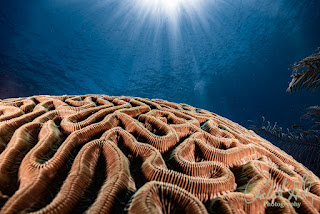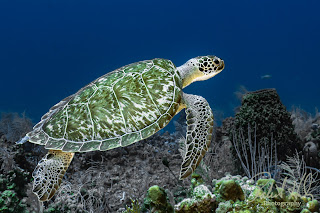Creating Custom AI Masks for Nudibranchs, Seahorses & More: Lightroom's Subject Detection at Macro Scale
Explore more tips at info.robertherb.com/lm-2-blog
Have you ever captured what you thought was the perfect nudibranch shot, only to discover later that Lightroom's automatic 'Select Subject" mask either missed the tiny creature altogether or mistakenly selected the entire coral head instead of that delicate, inch-long superstar? If so, you're not alone. Underwater macro photography is a delicate dance involving light, patience, and a keen eye for detail. But when it comes to post-processing, we underwater enthusiasts need tools that are just as precise and reliable as our shooting techniques.
Thankfully, the latest updates in Adobe Lightroom Classic v14.4 and Lightroom Mobile v9.4 have made significant strides with their advanced AI masking features. These powerful tools are designed specifically to help us isolate and enhance even the smallest subjects, all without disrupting that beautiful, dreamy blue bokeh that makes underwater photos so magical.
In this friendly walkthrough, I'll share tips and tricks on how to leverage Lightroom's newly improved features like Subject Detection, Object Selection, and Brush Refinement. Together, we'll learn how to craft custom AI masks that perfectly suit those tricky macro shots, whether it's a shy seahorse hiding among gorgonians or a translucent shrimp tucked inside an anemone. These tools are truly game-changers, making your post-dive editing process faster, smarter, and, best of all, more rewarding. Dive in with me and discover how to bring out the best in your tiny underwater worlds!
I want to thank some of my photography students who have submitted photos for editing. I have used some of them to generate this blog and some of the examples below.
Why This Matters for Macro Shooters
Most macro photographers today, whether you're shooting with a sleek, housed iPhone fitted with clip-on wet lenses or using a professional mirrorless camera equipped with a 60mm macro lens, face similar challenges when it comes to post-processing. These challenges include tiny subjects that can easily blend into noisy or busy backgrounds, making it difficult to isolate your subject. Depth-of-field blur can further complicate things, causing selections to become imprecise and requiring extra effort to perfect. Additionally, achieving the right balance of local adjustments, such as Texture, Clarity, and Exposure, without disrupting the overall ambiance or mood of the scene can be tricky.
This is where Lightroom's AI masking tools truly shine. When used thoughtfully and with some finesse, they can transform your editing workflow, making it easier to highlight your subject and bring out the best in your underwater macro shots. I've learned through experience that understanding how to leverage these masks can save you a lot of time and frustration.
In this post, I'll walk you through five real-world examples that demonstrate how to master these techniques. Whether you're a beginner looking to improve your edits or a seasoned pro wanting to refine your skills, these tips will help you elevate your underwater macro photography. So, let's dive in and explore how to make the most of Lightroom AI masks to create stunning, professional-looking images that truly capture the wonders beneath the waves.
🛠 Example #1: Isolating
a Nudibranch on Colorful Coral
🪸 Use Case: A
Hypselodoris nudibranch crawling across a sponge-covered rock
📷
Shot with: 60mm macro at f/11, ISO 400, strobe + snoot
Steps:
- Open
the image in the Develop Module
🔑 Shortcut: D - Open
Masking Panel
🔑 Shortcut: Shift + W - Use Select
Subject
→ Lightroom will often choose the nudibranch body but may miss rhinophores or trailing edges. - Refine
with Add: Brush to paint
in missed edges manually
🔑 Shortcut: K - Apply Texture
(+30) and Clarity (+20) to bring out skin detail without
touching the sponge texture
🎯 Result: The
nudibranch becomes the focal point without lifting exposure on the background.
Sponge bokeh stays creamy and untouched.
🛠 Example #2:
Highlighting a Tiny Seahorse in Murky Gorgonian
🪸 Use Case: Pygmy
seahorse camouflaged on pink gorgonian at 70 feet
📷
Shot with: Olympus TG-7 + Backscatter Mini Flash
Steps:
- Use the Object
Selection Tool
→ Draw a box around just the seahorse - If AI
misses the outline, switch to Add: Brush and use a small, feathered brush (Flow: 60) to gently refine
- Boost Exposure
(+0.25), Sharpness (+25), and Dehaze (+10) only to the
mask
🎯 Result: The
seahorse "pops" with structure and contrast, while the delicate fan structure
remains softly backlit.
🛠 Example #3: Enhancing
a Translucent Shrimp Without Bleeding Into the Anemone
🪸 Use Case: Glass
shrimp in a bubble-tip anemone
📷
Shot with: Sony A7R II + 90mm macro, f/13, dual strobes
Steps:
- Use Select
Subject → If it fails, try Select Object with a tight rectangle
- In the
mask, apply:
- Whites
(+15)
- Clarity
(+25)
- Texture
(+20)
- On the
Background (Invert the mask), drop Highlights (-10) to
preserve soft anemone light glow
🎯 Result: The
translucent body becomes visible with enhanced edges, but you retain the
delicate lighting of the anemone tentacles.
🛠 Example #4: Bringing
Out Eyes and Details on a Blenny
🪸 Use Case:
Sharp-eyed blenny peeking from coral with bokeh-rich background
📷
Shot with: Canon R5 + 100mm macro + snoot
Steps:
- Use Select
Subject → AI will generally grab the full fish
- Refine
with Subtract: Brush to remove unwanted coral or shadows
- Zoom
in, then apply:
- Texture
(+40) to the eye
- Sharpness
(+30) to head only
- Use a second
mask with a radial gradient over the head and eyes for a subtle
vignette
🎯 Result: You get
tack-sharp eye contact while keeping the natural softness in the rest of the
frame.
🛠 Example #5: Lightroom
Mobile Masking on-the-Go
🪸 Use Case: Macro
crab edit during surface interval on a tablet
📱
Shot with: iPhone 15 Pro + Kraken Smart Housing + SeaLife 2500 light
Steps:
- Open
Lightroom Mobile (v9.4 or newer)
→ Tap Edit > Masking > Subject Select - Add Texture
(+20) and Sharpness (+15)
- Use Luminance
Range Mask to select shadow zones behind the crab
→ Tap "Add Mask > Luminance Range" and drag to isolate - Reduce
Noise (-15) and Black Point (-5) to darken surroundings
🎯 Result: The
crab's shell detail becomes crisp, while the murky background fades away.
✨ Pro Tips for Success
- Always
Zoom In (Z) when refining AI masks. Tiny marine life needs precision.
- Toggle
Mask Overlay (O) to visualize what's being affected.
- Use Object
Selection over Subject Select when your critter is less than
1" across.
- Reset
Sliders by double-clicking the slider name if your edits go too far.
🧪 Compatible File Formats
for AI Masking
|
Tool |
Compatible File Formats |
|
Select Subject & Object |
RAW (DNG, CR3, ARW, ORF), JPG, HEIC, TIFF |
|
Brush / Radial / Gradient |
All Formats, including exported TIFFs or PSDs |
|
Lightroom Mobile |
DNG, JPG, HEIC (performance may vary with file size) |
🐚 Final Thoughts: Sharpen
Your Focus—Literally
Lightroom's AI-powered masking tools have truly revolutionized underwater photography editing. They're no longer just for capturing impressive wide-angle reef shots or stunning diver portraits. With a bit of practice and the right techniques, you can now apply exact, non-destructive adjustments to even the tiniest underwater subjects, think nudibranchs, tiny seahorses, shrimp, and more.
This means you can bring out incredible detail, clarity, and vibrant contrast in those delicate, often overlooked subjects, all without muddying the beautiful bokeh or the natural magic of your underwater scenes. The blend of automated detection and manual refinement gives you the best of both worlds: efficiency and control.
So, whether you're a seasoned underwater photographer or just starting to explore macro photography beneath the waves, Lightroom's intelligent tools can help you achieve spectacular results. Dive deep into your editing process, zoom in to reveal those minute details, and let Lightroom's innovative features help bring your underwater macro vision to the surface. Happy editing, and until next time, keep exploring and capturing the wonders of your underwater world!
🐠 Ready to Dive Deeper?
Follow my weekly blog at Robert Herb Photography Blog
Share your results using #RobertHerbPhotography
🧭 What's Next?
🟦 Have you tried the new Custom AI Mask Tools yet? Share your edits using #RobertHerbPhotography.
🟦 Want to see these workflows in action? Sign up for my upcoming training course at RobertHerb.com or reach out at bob@robertherb.com
🟦 And don't forget—new blogs drop weekly at Robert Herb Photography Blog
Until next time… dive deep, shoot smart, and let Lightroom bring your vision to the surface.
Written by Robert Herb – Empowering underwater photographers to capture and enhance the beauty of our oceans since 1978
Stay tuned for more in-depth insights into underwater photography. Let's dive deeper into the art and craft of capturing the marine world! If you have any comments or suggestions, I'd love to hear them.
Get ready for an exciting underwater photography adventure! For more details on my upcoming online training course, check out my "Training" page at RobertHerb.com or email me at bob@robertherb.com.
Sincerely,
Bob Herb
|
|





Comments
Post a Comment
Please let me know your comments.